
The Illinois Central Railroad, sometimes called the Main Line of Mid-America, was a railroad in the Central United States. Its primary routes connected Chicago, Illinois, with New Orleans, Louisiana, and Mobile, Alabama, and thus, the Great Lakes to the Gulf of Mexico. Another line connected Chicago west to Sioux City, Iowa (1870), while smaller branches reached Omaha, Nebraska (1899) from Fort Dodge, Iowa, and Sioux Falls, South Dakota (1877), from Cherokee, Iowa. The IC also ran service to Miami, Florida, on trackage owned by other railroads.
Illinois Central Railroad Depot, and variations, may refer to:

Carbondale station is an Amtrak intercity train station in Carbondale, Illinois, United States. The southern terminus of Amtrak's Illini and Saluki routes, it is also served by the City of New Orleans. Amtrak Thruway service between Carbondale and St. Louis, Missouri connects with the City of New Orleans. Carbondale is the southernmost Amtrak station in Illinois.

Baton Rouge station is a historic train station located at 100 South River Road in downtown Baton Rouge, Louisiana. It was built for the Yazoo and Mississippi Valley Railroad which got absorbed by the Illinois Central Railroad. The station was a stop on the Y&MV main line between Memphis, Tennessee and New Orleans, Louisiana. The building now houses the Louisiana Art and Science Museum.

The Atchison, Topeka and Santa Fe Passenger and Freight Complex is a nationally recognized historic district located in Fort Madison, Iowa, United States. It was listed on the National Register of Historic Places in 1992. At the time of its nomination it contained three resources, all of which are contributing buildings. The buildings were constructed over a 24-year time period, and reflect the styles that were popular when they were built. The facility currently houses a local history museum, and after renovations a portion of it was converted back to a passenger train depot for Amtrak, which opened on December 15, 2021.

The Chicago, Milwaukee, St. Paul and Pacific Railroad Depot and Lunchroom are two buildings located in Wells, Minnesota, and built by the Chicago, Milwaukee, St. Paul and Pacific Railroad in 1903.

The Chicago, Rock Island and Pacific Railroad Passenger Station is a historic building located in Iowa City, Iowa, United States. Built in 1898 for passenger use, it was the second depot in the city. The first one was built by the Mississippi and Missouri Railroad, a predecessor of the Chicago, Rock Island and Pacific Railroad (CRI&P), in 1855. This one was built through the efforts of Harry Breene, the local Rock Island agent. W.K. McFarlin, CRI&P's superintendent of maintenance and construction oversaw the building's construction. Architecturally, it is a combination of the Richardsonian Romanesque and Victorian Romanesque. The depot was built to similar designs of stations in Ottawa, Illinois, and Council Bluffs, Iowa.

The Burlington, Cedar Rapids and Northern Railway (BCR&N) was a railroad that operated in the United States from 1876 to 1903. It was formed to take over the operations of the bankrupt Burlington, Cedar Rapids and Minnesota Railway, which was, in turn, the result of merging several predecessor lines, the construction of which began in 1869. The corporate headquarters were in Cedar Rapids, Iowa, and it had operations in Iowa and in Minnesota. It was succeeded by the Chicago, Rock Island and Pacific Railway.
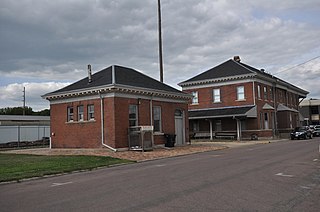
The Illinois Central Railroad Yard, also known as Cherokee Illinois Central Station, is a nationally recognized historic district located in Cherokee, Iowa, United States. It was listed on the National Register of Historic Places in 1990. Cherokee was a hub for the Illinois Central Railroad's (IC) branch lines, and the railroad's westernmost division headquarters in the state. The district was a collection of structures that were associated with the IC's second and third building phases, 1860 to 1870 and 1886 to 1888, and the expansion of the roundhouse in 1915. It represented the last of the pre-Diesel era railroad yards left in Iowa. At the time of its nomination it contained 17 resources, which included seven contributing buildings, one contributing structure and nine non-contributing buildings. Ten of the buildings were of frame construction and seven were brick. Most of the buildings no longer exist, having been replaced by an agricultural cooperative. The former depot and American Express building remain.

Illinois Central Passenger Depot-Storm Lake, also known as the Storm Lake Depot, was an historic building located in Storm Lake, Iowa, United States. The Iowa Falls & Sioux City Railroad, an Illinois Central Railroad (IC) subsidiary, built the first tracks through town in 1870. They also built a two-story frame combination freight and passenger depot the same year. The present depot is a second generation IC structure built of brick. The building's architectural style is Prairie School with Tudor Revival elements in the dormer and canopy ends. It was designed by IC architect E.E. Bihl, and it is similar to the railroad's depots in Flossmoor, Illinois and Fort Dodge, Iowa. The new passenger depot was completed in August, 1915, and the old depot was re-purposed for a dedicated freight depot. It was torn down sometime before 1948. Passenger service remained high during the 1910s and 1920s, with the decline accelerating after World War II, and it ended all together in the late 1960s. While freight trains continue to use the IC's tracks, the depot has been abandoned. It was listed on the National Register of Historic Places in 1990. The Storm Lake Illinois Central depot was demolished on February 25, 2013.

The Chicago and North Western Office Building/Passenger Depot-Lake City, also known as the Lake City Depot, is a historic building located in Lake City, Iowa, United States. The Toledo & North Western Railroad (TNW) laid the first tracks through town in 1881–1882. Because Lake City was already established, they built a two-story, frame, combination depot and the southeast edge of town. Because of its convenient location, the TNW also built their repair and maintenance shops in Lake City in the 1880s. They placed their division headquarters here in 1887. The Chicago and North Western Railway (CNW) acquired controlling interest in the TNW in June 1881, and ran it separately until it formally acquired it in 1890.
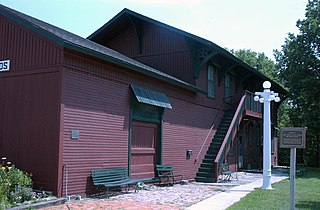
The Burlington, Cedar Rapids, and Northern Railroad-Rock Rapids Station, Railroad Track and Bridge is a nationally recognized historic district located in Rock Rapids, Iowa, United States. It was listed on the National Register of Historic Places in 1976. At the time of its nomination the district included one contributing building and three contributing structures.

The Sac City Chicago and North Western Depot is a historic building located in Sac City, Iowa, United States. The city was platted in 1855, and soon after they began to campaign for a rail line into the town. It took 23 years before the railroad arrived. The Maple River Railroad was the first to lay tracks in Sac County in 1877, but it went to Wall Lake rather than Sac City. The Sac City & Wall Lake Railroad was formed that year and the tracks were laid between the two towns in 1878. The Chicago & North Western Railroad acquired the line in 1884, and built a two-story frame depot in Sac City. The business district grew up around the depot. In 1916 the Chicago & North Western replaced the frame depot with this single story brick depot a block to the south. It was a combination depot, passenger and freight, that utilized Chicago & North Western's Number One standard plan.

The Mills Tower Historic District is a nationally recognized historic district located in Iowa Falls, Iowa, United States. It was listed on the National Register of Historic Places in 1990. At the time of its nomination the district consisted of six resources, including two contributing buildings, and four non-contributing buildings. All of the buildings are associated with the Illinois Central Railroad (IC). The Dubuque & Sioux City Railroad, an affiliate of the IC, laid the first rail track to Iowa Falls in 1866. The following year the Iowa Falls & Sioux City Railroad, another IC affiliate, continued construction of the line to the west, and it reached Sioux City by 1870. The Burlington, Cedar Rapids and Northern Railway (BCR&N) by way of its affiliate the Cedar Rapids, Iowa Falls & North Western, entered Iowa Falls in 1880. Two years later it was expanded to the north and intersected with the IC main line, which required a controlled crossing. Little is known about this first crossing and what it contained.
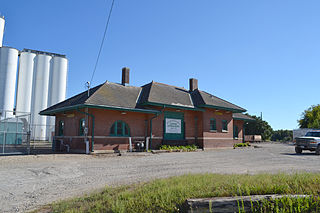
Iowa Falls Union Depot is a historic building located in Iowa Falls, Iowa, United States. The Dubuque & Sioux City Railroad, an affiliate of the Illinois Central Railroad (IC), laid the first rail track to Iowa Falls in 1866. The following year the Iowa Falls & Sioux City Railroad, another IC affiliate, continued construction of the line to the west, and it reached Sioux City by 1870. They built a plain, two-story frame depot to serve Iowa Falls. The Burlington, Cedar Rapids and Northern Railway (BCR&N) by way of its affiliate the Cedar Rapids, Iowa Falls & North Western, entered Iowa Falls in 1880. They built their own depot. It was basically another east–west route, but local business leaders desired a north–south route to serve the community.

The Chicago Great Western Railroad-Waterloo Freight Depot is a historic building located in Waterloo, Iowa, United States. In 1887 the Chicago, St. Paul & Kansas City Railroad (CSP&KC) was the third system to enter the city, after the Illinois Central (1870) and the Burlington, Cedar Rapids and Northern Railway (1876). The CSP&KC was the first of the three to put its depots in the downtown area. Initially it built two depots in Waterloo, one on the west side of the Cedar River and one on the east side. By 1892 it had built separate passenger and freight depots along East Sixth Street. That was the same year that the CSP&KC became known as the Chicago Great Western Railroad. In 1903 the railroad built new passenger and freight depots a block south, moving them closer to the city's wholesale houses. The two-story concrete block freight depot was built on a rough limestone foundation. It features round arch freight doors and a simple wood cornice. The concrete block addition on the southeast side replaced a frame gabled structure, but its construction date is unknown. The old brick passenger depot was torn down in 1973, and the freight depot was listed on the National Register of Historic Places in 1997. In 2001 the building, which is owned by the City of Waterloo, was leased to the University of Northern Iowa for its Center for Urban Education (UNI-CUE).
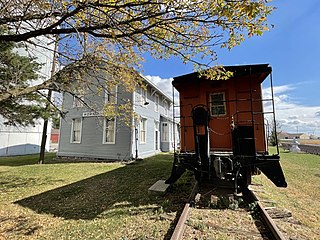
The Chicago, Milwaukee, St. Paul & Pacific Combination Depot-Hornick, also known as the Hornick Depot, is a historic building located in Hornick, Iowa, United States. The town was patted by the Chicago, Milwaukee, St. Paul & Pacific Railroad's land company when the railroad created a branch line from Manilla, Iowa to Sioux City. Completed in 1887, the railroad built this two-story frame structure to serve as its passenger and freight depot. It is one of six such depots that remain in Iowa, and the best preserved. These buildings were built from a standard design used by the railroad. The two-story stations included living quarters for the station manager because the towns had yet to develop when the depot was built. This was an island depot, with freight loaded on the north side and passengers boarded on the south. Decorative elements on this depot include lathe-turned wooden finials, angled wooden brackets, and bracketed door and window hoods. Passenger service ended in the 1950s, and grain was loaded here until 1980 when the Milwaukee Road abandoned the Sioux City branch line. The building was listed on the National Register of Historic Places in 1990. It has been converted into a local history museum.

The Lewis System Armored Car and Detective Service Building, also known as the Bell Tire and Rubber Company (Service Company) and Sioux City Tent and Awning, is a historic building located in Sioux City, Iowa, United States. F.A. Martin and Richard Nash, who owned the property, had this two-story brick commercial building constructed in 1929. KB Construction (Federation Construction Company), who built the building, occupied the second floor. Bell Tire and Rubber Company was the first business located on the first floor from 1930 to 1933. A few other businesses occupied the space until Sioux City Tent and Awning was located here from 1937 to 1941. The following year Lewis System moved in and remained until 1969. The second floor was converted into apartments about 1950.
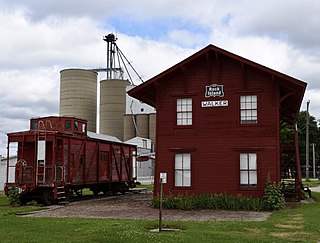
Walker Station is a historic building located in Walker, Iowa, United States. The two-story frame building with bracketed eaves was completed in 1873 along the Burlington, Cedar Rapids, and Minnesota Railway tracks. The depot also served its successor railroads: the Burlington, Cedar Rapids and Northern, and the Chicago, Rock Island and Pacific. Typical of many railroad towns in the Midwest, this is the first building that was built here and the town grew up around it. It is an example of a combination depot that was used for both passenger and freight usage in smaller communities. Because it has a ground level brick platform, service here was primary passenger and light freight service. A higher level of freight service would have required a raised platform.

Le Mars Downtown Commercial Historic District is a nationally recognized historic district located in Le Mars, Iowa, United States. It was listed on the National Register of Historic Places in 2012. At the time of its nomination the district consisted of 96 resources, including 73 contributing buildings and 23 non-contributing buildings.






















